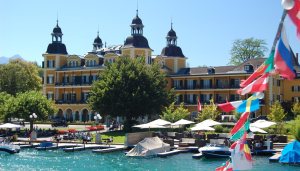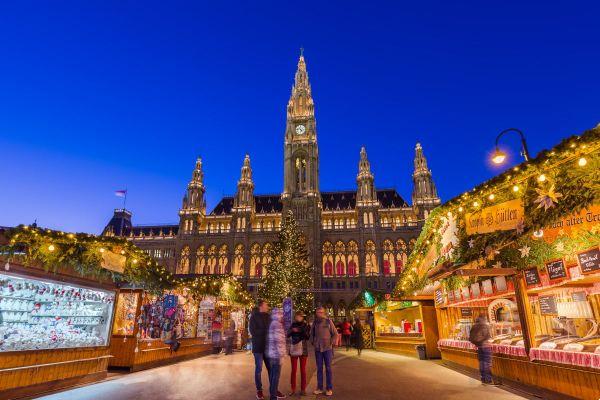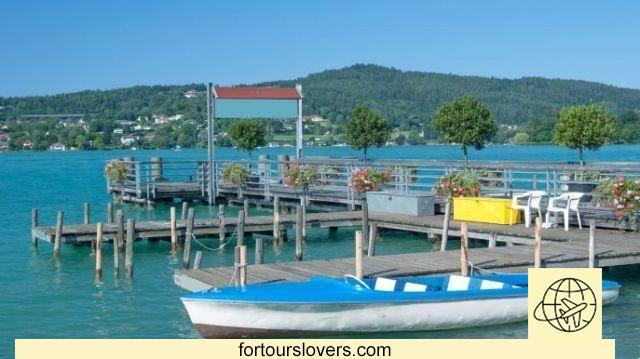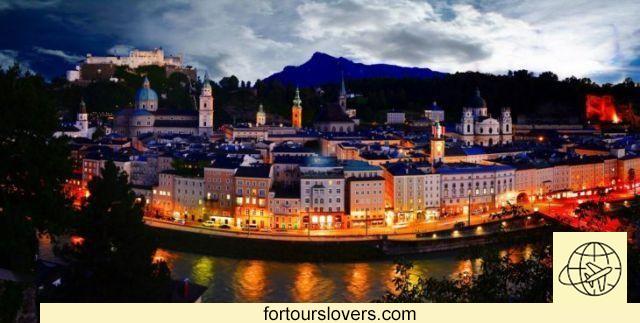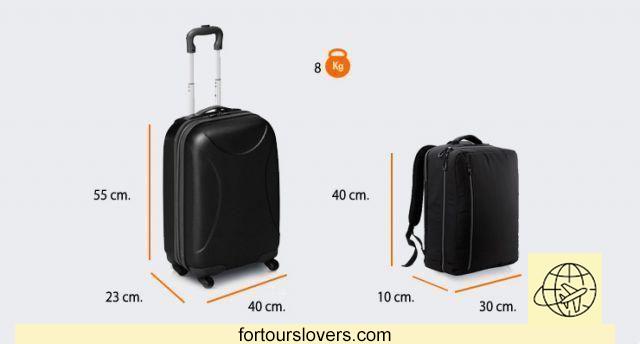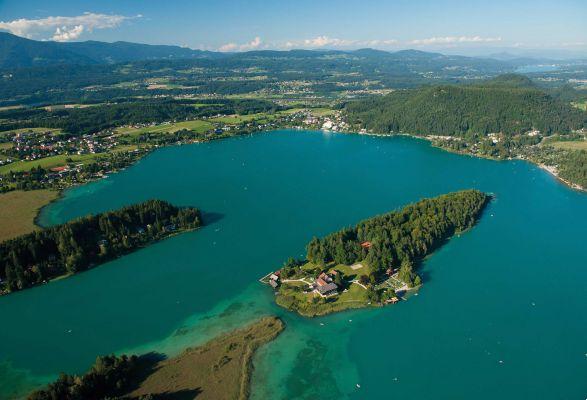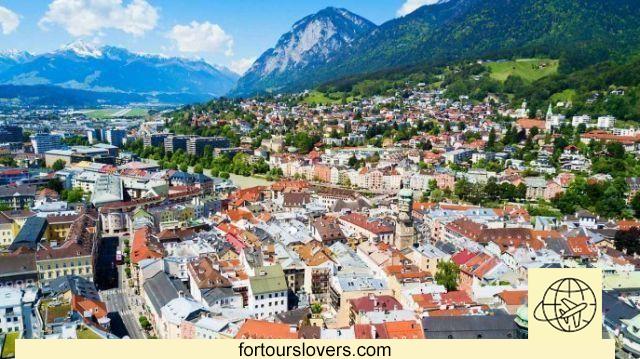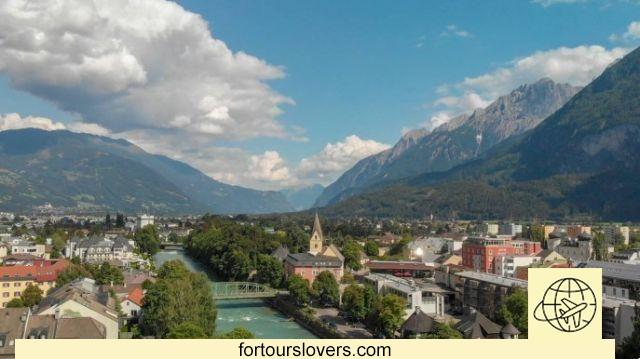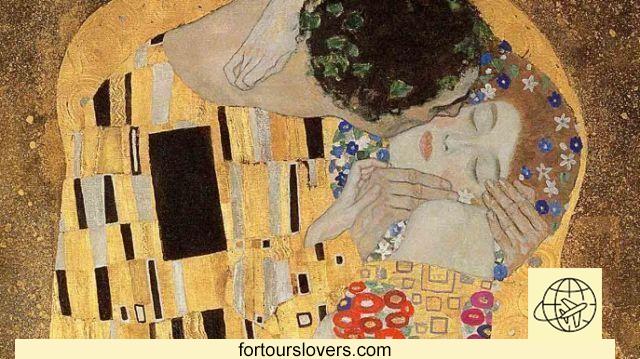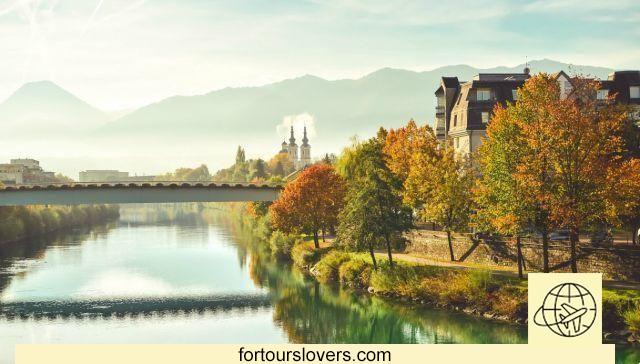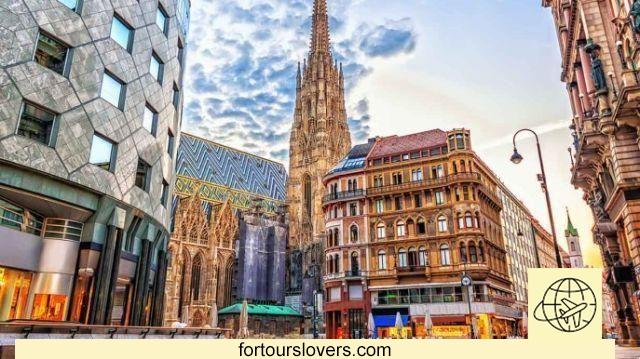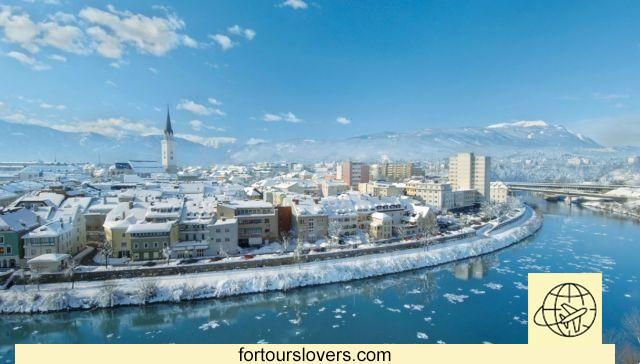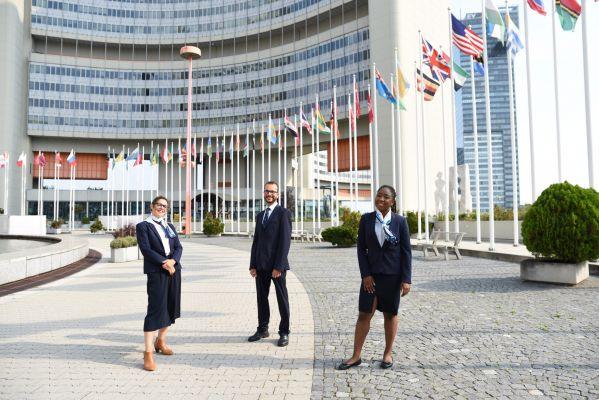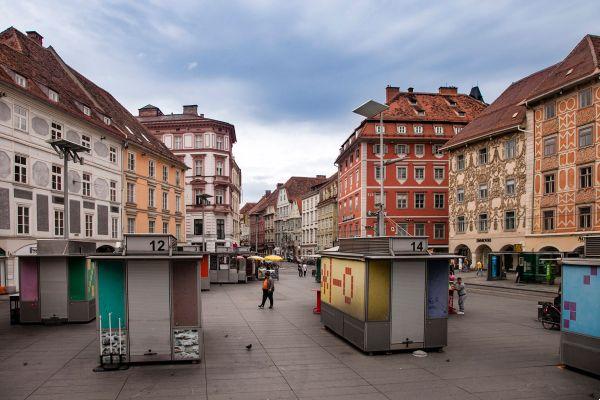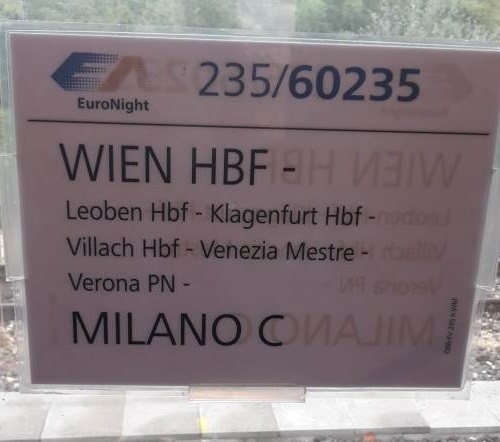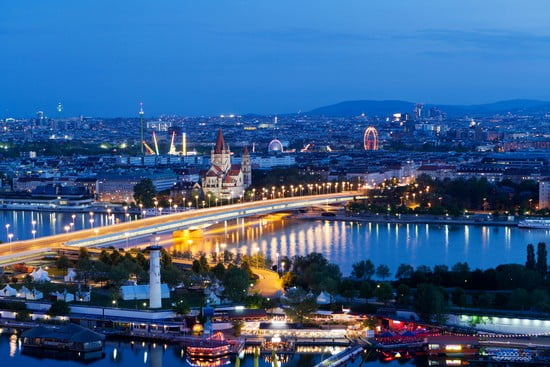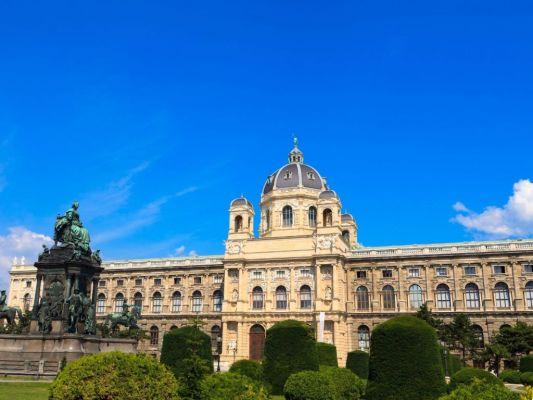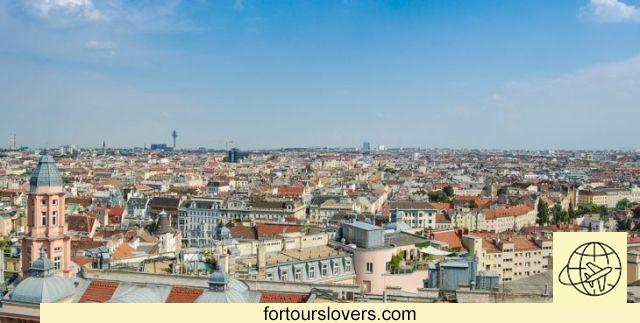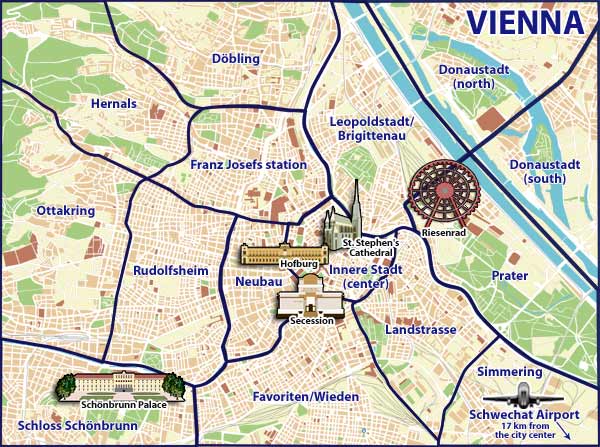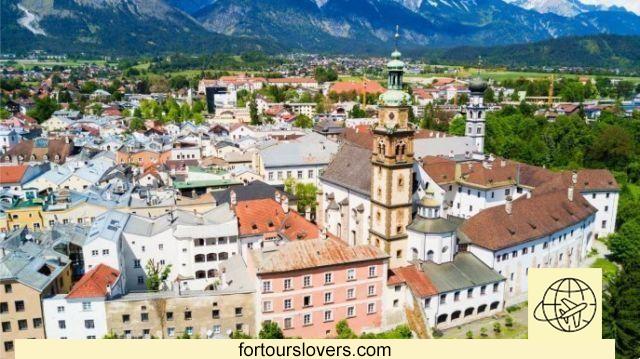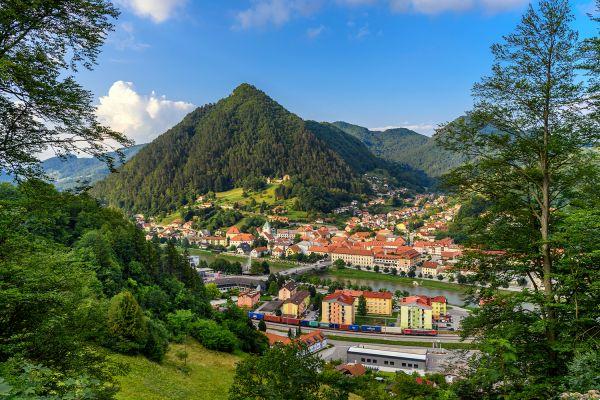Before writing this post on what to see in Salzburg and surroundings it is necessary to make a clarification: in Salzburg talking about the historic center is not entirely correct.
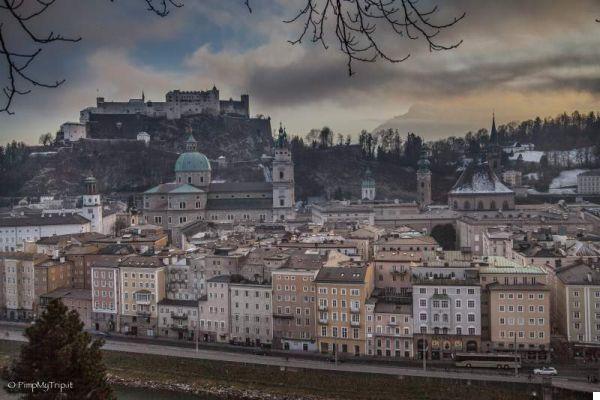
The City of the Prince, or the "left" historical center
The center of Salzburg is divided into two parts by its river, the Salzach: with our backs to the source we have on the left the "City of the prince" with the cathedral, the fortress and its sumptuous palaces. On the right there is the Mirabell Castle, the Capuchin convent and other places of historical interest.
For this reason, when we talk about Salzburg, a distinction is made between the “left” historic center and the “right” historic center.
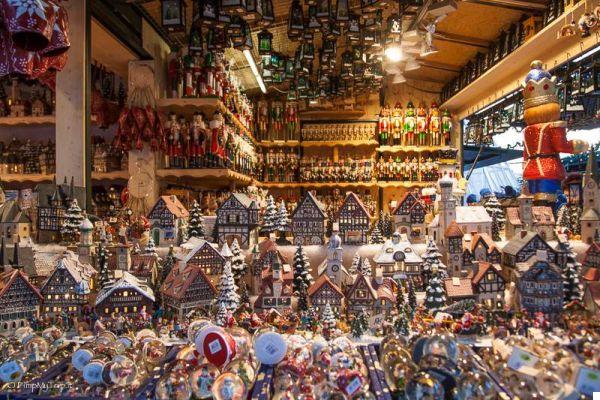
During the holidays, the squares of Salzburg are enlivened by colorful and cheerful Christmas markets
I visited Salzburg and its surroundings before Christmas, enjoying its Christmas atmosphere. Two or 3 days are the minimum to dedicate to this wonderful city.
Advise! If you want to make many visits, think about buying the Salzburg Card which entitles you to free admission to all places of considerable interest and museums. In addition, all public transport in the city are included.
- The Old Town on the left of the river: the City of the Prince
- The Old Town to the right of the river
- Out of the Center
- What to see around Salzburg
To the left of the Salzach: the "City of the Prince"
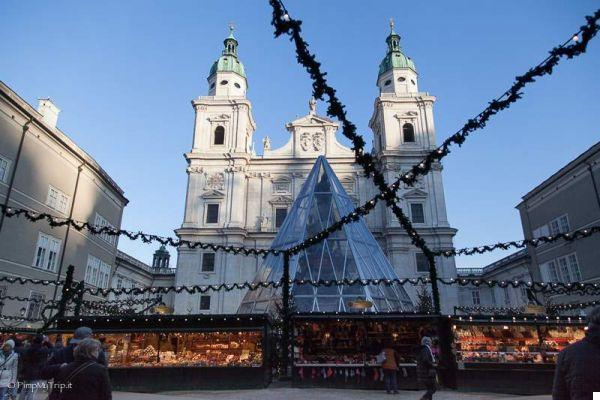
The market is behind the facade of the Salzburg Cathedral
To immediately get a first idea of how the city was structured, I began my two days with a visit to the Hohensalzburg Fortress: the panorama from the top offers wonderful views over the roofs of the city. You can go up to the fortress in two ways: either by funicular, or on foot. I chose the first option because the road to the top is quite steep and tiring.
I believe that in all of Europe there is no such well-preserved medieval castle as this one. Its construction began in 1077 when Archbishop Gebhart, fearing the revenge of the princes of medieval Germany, thought of building a fortress in which to be safe. Over the next 600 years the fortress was expanded to its present size.
Inside the fortress you can visit the torture room, the Reckturm tower, the prisons and the Slazburger Stier, an organ from 1520. Since September 2000, after extensive renovations, the Fortress Museum with some really interesting finds such as the Romanesque arched windows, but the apex of the visit are undoubtedly the apartments of the prince.
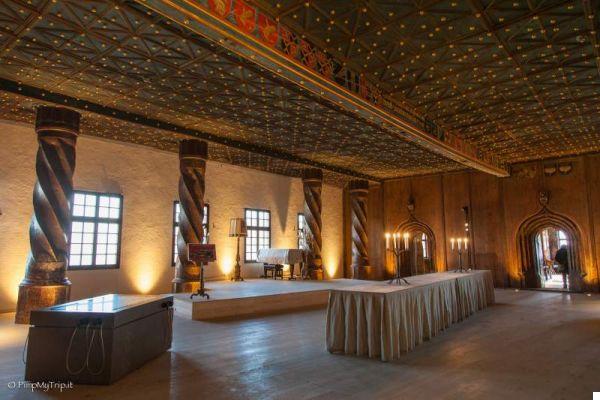
The Goldene Saal or the golden room, where receptions were held
There are three rooms decorated with late Gothic gilded carvings. In Golden room (the golden room) there is also a wonderful tiled stove. There Golden Hall (Golden Hall) that is the hall where the receptions were held is truly impressive with the four Ardnet marble columns supporting the ceiling.
On the outside, the Church of St. George and its marble reliefs of the twelve apostles and on the outside, the marble relief depicting Leonhard, the archbishop who had the church built.
The view over the city from Kuenburg bastion leaves you breathless: I stopped for a few minutes with my gaze wandering over the roofs of the city, sipping a spicy Gluwein.
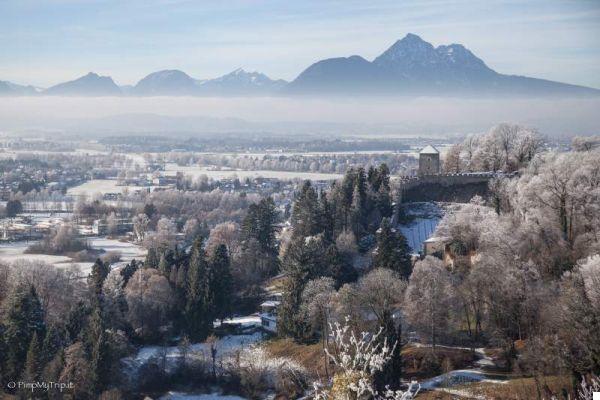
Panorama from the rampart of Salzburg Castle, sipping a spicy Gluwein!
Coming down from the fortress (in which I spent more than two hours) and crossing the piazza del Capitolo, I found the marble facade of theUntersberg, Salzburg Cathedral.
Reopened in 1959, after a bomb during the Second World War had heavily damaged it, the cathedral presents itself with its grandiose interior: the main nave is majestically decorated with frescoes that represent, in the larger images, the Passion of the lord and in the ovals the miracles of Christ.
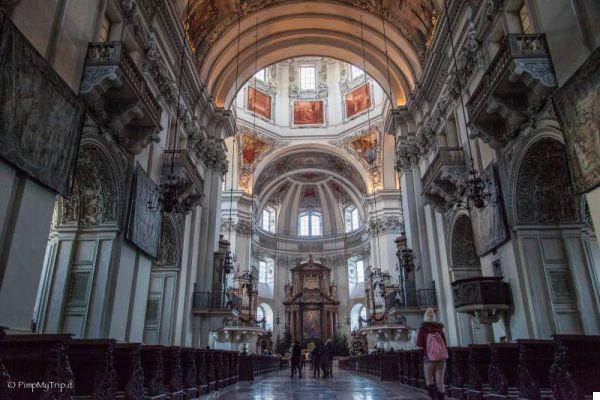
Interior of the cathedral
From the historical-artistic point of view, one of the most important treasures of the cathedral is the baptismal font.
“Domquartier”: around the cathedral square there are 3 buildings: the cathedral, the Old Residence and the Convent of San Pietro. Since 2014, a path has been set up that allows you to visit the museums and galleries inside them. this tour is extremely interesting, its name is Domquartier.
North of the cathedral is the most important square of the city: Residence Square (Residenzplatz) at this time of the year occupied by the Christmas market. In the center of Residenzplatz, there is a large marble fountain, the Fountain of the Residence, the largest Baroque fountain of which I, alas, was able to admire only the upper part due to the stalls around it.
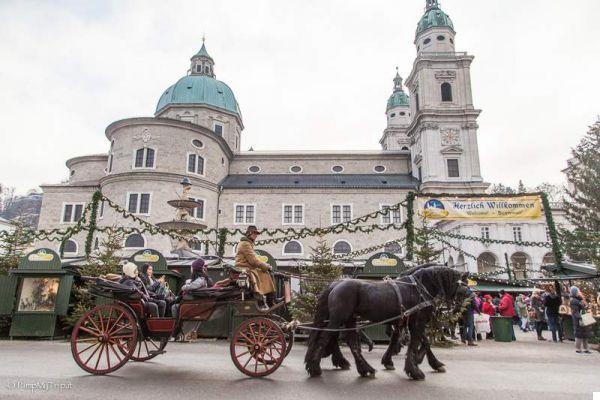
Residenzplatz: in front of the cathedral, on the right there is the Old Residence and on the left the New one
The Old and New Residence overlook the Residenzplatz.
La Old Residence it was built between 1595 and 1619 and the visit took me through its ancient Gala Rooms including the Sala dei Carabinieri which served as a theater and party room. In the conference room, a child prodigy named Wolfgang Amadeus Mozart, at the age of only 6, gave his first concert.
Right in front of the Old Residence is the New Residence, famous for its tower from which the carillon plays three times a day. Inside the New Residence the Salzburg Museum.
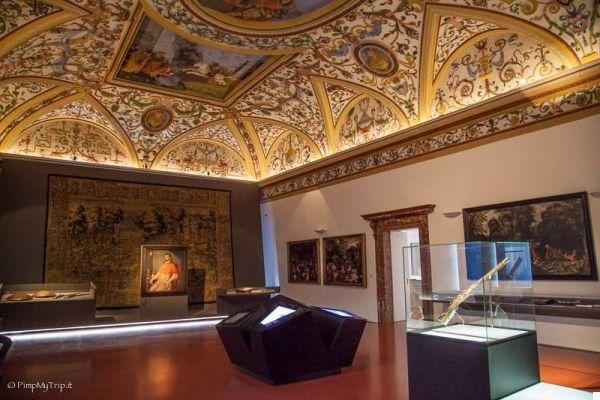
Museum room located in the New Residence
Overshadowed by the mighty cathedral, the little one Church of San Michele it often goes unnoticed. Too bad since it is almost a thousand years older than the cathedral; to the north east of Piazza Residenza the bronze statue of Mozart makes a fine show of itself in the square of the same name.
At this point I decided to stop and rest a bit since with all the things to see in Salzburg I skipped lunch.
I stopped at the most famous café in town, the Tomaselli coffee and I indulged in an orange punch and a slice of apple strudel. I would have liked to taste the typical cake, the Salzburg dumplings, a souffle with currant jam.
The cake, however, is for three people and has a fairly high price: from 18 euros upwards, so I limited myself to photographing it.
The three fluffy peaks, sprinkled with powdered sugar, represent the snow-capped mountain peaks that surround the beautiful and historic city of Austria.
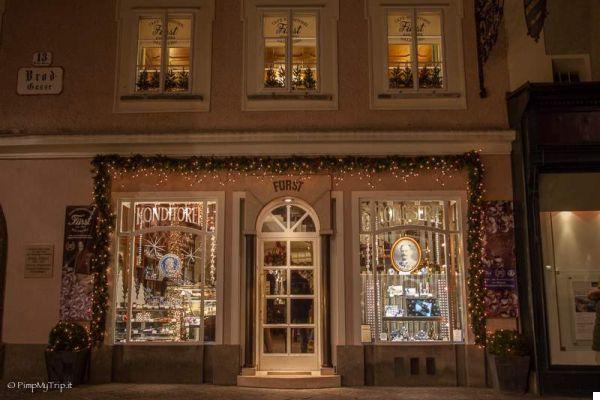
The window of Furst, the pastry shop of the famous "Mozart balls"
After the break I stopped to look at the shop window Furst, the pastry shop of the famous "Mozart balls" of chocolates with a heart of soft marzipan and then I walked the Getreidegasse, the main street and for centuries the commercial center of the city.
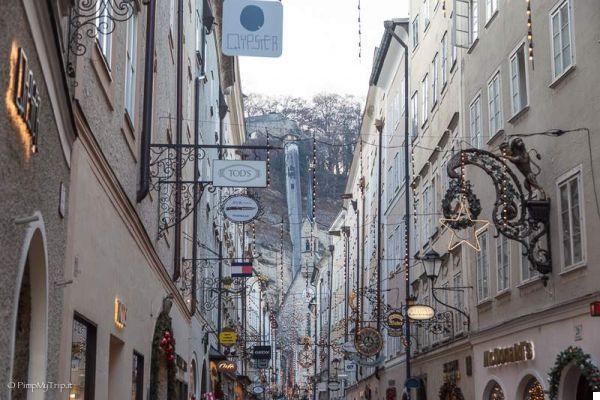
Getreidegasse: the medieval wrought iron signs are the main feature of the main commercial street of the city. Unfortunately, the big international brands are slowly taking the place of the old traditional shops.
The shop signs on Getreidegasse, in wrought iron and partly gilded, they have their origins in the Middle Ages. Unfortunately today due to competition from shopping centers, shops in Getreidegasse are closing one after another and the brands of large multinational groups are now flooding the street.
Equally interesting are the various side covered passages, which unite the Getreidegasse to parallel streets and pretty courtyards.
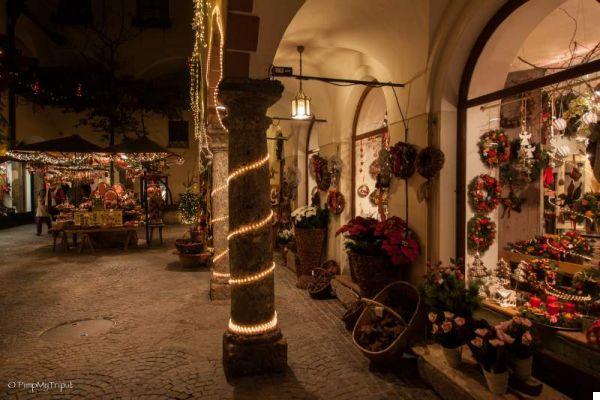
A courtyard a few steps from the Getreidegasse
The yellow house at 9 Getreidegasse would almost go unnoticed were it not for the groups of visitors entering and exiting the street door. Just look up to notice the golden writing in large letters: Mozart's birthplace, the birthplace of Amadeus Mozart.
The museum inside the house has been set up since 1880: today not only the musical instruments of the child prodigy (the violin and the clavichord played by the little Mozart) are on display, but also furniture, portraits, letters of the family and autographs. The heart of the museum is the third floor apartment, where Amadeus was born on January 27, 1756.
From Mozart's house, I then headed towards the Universitatsplatz, crossed the portal and found myself in front of the Church of the College, one of the most beautiful architectural works of the High Baroque. In the square in front, the vegetable market (Grunmarkt) is held every day, where fresh vegetables are sold, but also cheeses, meat and fruit.
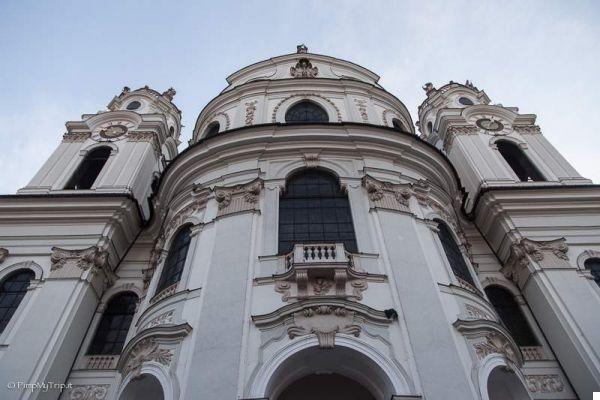
The imposing facade of the Collegio Church
Other things to see on the left of the river:
Hospital church: at the bottom of the Getreidegasse this church appears which, even from the outside, may seem banal and unadorned inside, the medieval vault and the murals are an artistic treasure.
Il dip (Pferdeschwemme): after the Civic Hospital there is the dip that was once the bath of the horses of the archbishop's stables. The horse tamer statue is by artist Michael Bernhard Mandl.
Big Festival Theater: we are in the city of music, how can we not take a trip to see the great Theater of the Festival? Opened in 1960, it seats 2400 people, the stage is 100 meters long, 60 meters high and 65 meters deep.
House for Mozart: banal and lacking in originality, this theater is praised for its acoustics.
Franciscan Church: this church is the pride of the inhabitants of Salzburg.
Convent of San Pietro: the oldest Benedictine community. In the courtyard the fountain of San Pietro makes a fine show of itself. The Abbey Church of San Pietro is the only Romanesque church in the city.
Right of the Salzach
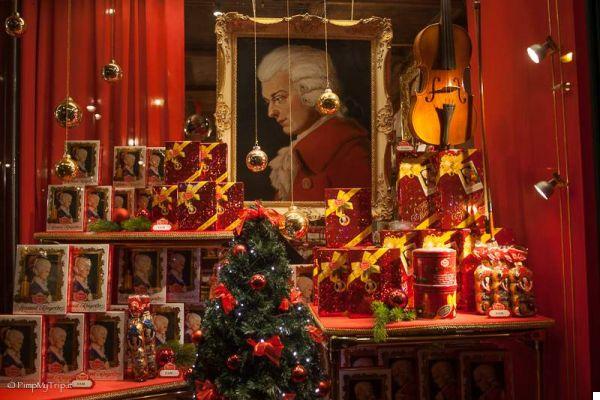
One of the many showcases of sweets dedicated to the most famous character: the great Amadeus Mozart! PS: but did you know that now they also make perfumes with his face?
There are several bridges and footbridges to cross the Salzach. I crossed the main bridge, lo State Bridge and I found myself in the small square "Platzl". From here I walked there Linzer Gasse, a pedestrian street lined with very beautiful bourgeois buildings, up to Cornelius-Reitsamer-Platz, with its fountains carved into the floor.
I walked back and forth along the Linzer Gasse, returning towards the Platzl and turning into the path to the left from which the stairs leading to the monte Kapuzinenberg and to the Capuchin convent. The stairs are steep, but in ten minutes I got to the top from which, from bastion Hettwer I enjoyed a magnificent view of the Prince's City across the river.
As an alternative to the stairs to get to the convent, you can instead take a via crucis of 6 stations and which starts from a portal dating back to 1617 located at Linzergasse 14.
Coming back from the Platzl I took the Dreifaltig-keitstrasse and found myself on the Makartplatz with the regional theater State Theater and Trinity church.
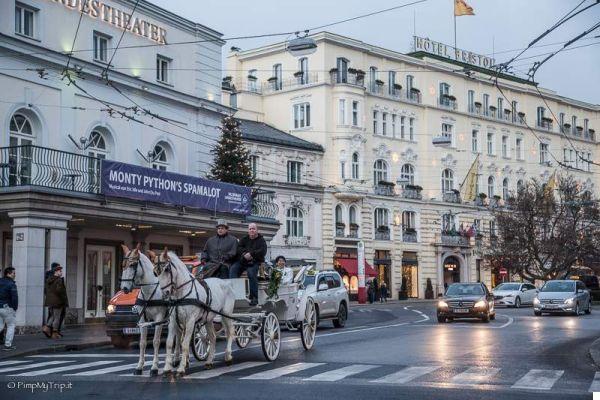
Makartplatz
Also from Makartplatz, along the passage between the Landestheatre and the hotel, the Mirabell gardens that, although some areas are closed to tourists in winter, it is worth visiting at any time of the year.
The fountain in the center of the garden is surrounded by four large marble groups that symbolize the 4 elements of nature, but the statue I liked the most is that of the Pegasus fountain. Going up a few steps from the Pegasus fountain you get to the garden of the little dwarves. Unfortunately when I went, this part of the Mirabell Gardens was closed.

The Mirabell Gardens and the Salzburg fortress in the background
Other things to see to the right of the river:
Mozarteum: the academy of music and visual arts is among the most famous in the world. The international Mozarteum foundation built its headquarters west of the Mirabell gardens and is one of the few Art Nouveau buildings in Salzburg. The foundation manages the two Mozart museums and organizes the "Mozart Week".
Mirabell Castle: the origin "Altenau" was built on the orders of Archbishop Wolf Dietrich for nothing less than his mistress. Today it is the seat of the municipal administration and its own marble room it is considered one of the most beautiful wedding halls in the world. Destroyed by a fire in the early 1800s, it was then renovated and its angel staircase gives an idea of the sumptuousness it must have had in the past.
Church of San'Andrea: heavily damaged during the 2nd world war, the church has completely lost its neo-gothic aspect. Today's church is ugly in my opinion, but on Thursday mornings in front of it the biggest weekly market in Salzburg takes place.
Outside the Center
Hellbrunn Castle and the water games: 4 km south of the center, in 1613, the archbishop, who was obviously a real rich man, had this country house built, which is a little oversized.
The water games reflect the way of life of the Renaissance: the archbishop liked it during the wild parties he organized to entertain his guests.
Untersberg cable car: the cable car takes you to the top of the Untersberg plateau. From there, a short walk takes you to the top of the Salzburger Hochthron.
Hangar-7: built by Red Bull at Salzburg Airport, the Hangar-7 is an architectural masterpiece.
What to see around Salzburg
If you have more time, don't miss a trip to the surroundings of Salzburg, especially to visit the idyllic Bavarian mountains.
In fact, 25 km west of Salzburg, already beyond the border that separates Austria and Germany, is the town of Berchtesgaden and its beautiful area around it. One of the most beautiful spots of color is certainly the Konigssee, a deep blue lake, which due to its position in the mountains, looks more like a fjord than a mountain lake.
In the Berchtesgaden area, a branch leads to theObersalzberg, sadly famous for the events related to Adolf Hitler. Here, in fact, the Fuhrer spent his summer holidays at his Berghof mountain chalet.
Today the Berghof no longer exists, instead there is a documentation center and the road leading to Eagle's Nest, a chalet-fortress given to the Fuhrer by the National Socialist Party and which can be visited.
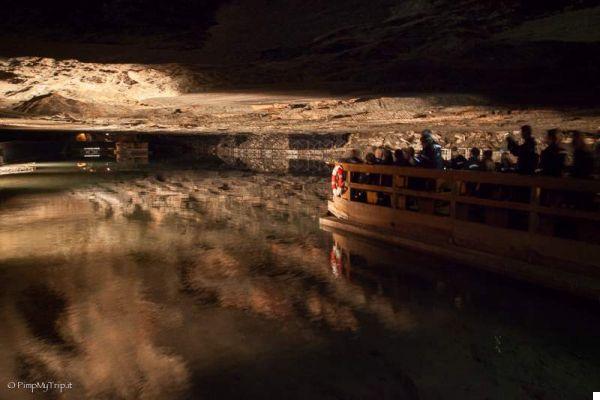
Cross a salt lake on a boat in the Hallein mines!
Hallein and the Salt Mines. I had been here a long time ago and had a wonderful memory. I admit that again I was extremely satisfied: the Hallein salt mines are fun and interesting for everyone, both young and old. The salt mines of Salzburg are the oldest mines in the world and for hundreds of years they brought great well-being to the populations, just think, there are traces that the Celts already extracted white gold here, more than 2500 years ago.
The route winds for about an hour and a half, between trains, slides and underground salt lakes. The interactive exhibition in the various rooms of the mine explains how the salt was created and how it is still extracted from the Dürrnberg mountain today.
Werfen and the World of Ice Giants: from the "Werfen" exit of the A 10 Tauern motorway it is about 35 minutes leading to the parking lot of the World of Ice Giants. From here with the funicular you reach 1700 meters of altitude, at the entrance of one of the largest ice cave systems in the world.
Ice curtains, bizarre formations, columns and gigantic domes accompany the traveler for about two hours. Open from May to October.
Other things to see around Salzburg:
Pinzgau: the panoramic road that leads to what is the largest mountain in Austria, the GlossGlockner, starts from the village of Bruck at over 2500 meters above sea level.
There are two dams of the reservoirs of Kaprun about 25 minutes by car from the village of Zell am See.
The Krimml waterfalls, one of the natural spectacles of the Pinzgau area, are about 40 minutes from Zell am See.
Il Salzkammergut: the area with its crystal clear mountain lakes, sloping rocks and green mountain pastures is, especially in summer, a small earthly paradise.
Hallstat: Due to the limited space available, the picturesque houses of Hallstat have been created one above the other on the rocky mountainside.




